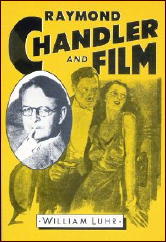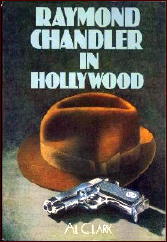Sat 28 Jul 2012
Reviewed by Walter Albert: Two 1980s Books on RAYMOND CHANDLER and HOLLYWOOD.
Posted by Steve under Authors , Mystery movies , Reference works / Biographies[6] Comments

WILLIAM LUHR – Raymond Chandler and Film. Frederick Ungar, hardcover/softcover, 1982; bibliography and index, photographs, filmography. Florida State University, trade paperback, 1991.
AL CLARK – Raymond Chandler in Hollywood. Proteus, hardcover/softcover, 1983; index, filmography. Silman-James Press, trade paperback, 1996.
I have paper editions of both these books: the Luhr is a 5-1/2 x 8″ yellowback, the cover sporting a portrait of Chandler set into an oval frame next to a pulp illustration; the Clark is a large-sized 8 x 10-3/4″ book, the cover featuring a brown hat with a revolver resting on the brim.
The Luhr pages are densely packed with text in small type, while the Clark is profusely illustrated with stills, lobbycards and other advertising material for the films. Luhr is an associate professor of English and film at St. Peter’s College, and Al Clark is a Spanish-born publicist and magazine editor who is currently creative director of the Virgin Records group, based in London.
The copy for Clark’s biography is probably written by him and is a tongue-in-cheek view of his life; Luhr’s credentials are presented soberly. The casual reader is likely to assume that Luhr is writing a serious study of Raymond Chandler’s Hollywood career and that Clark has put together an album for the film buff.

In fact, both books are valid contributions to the literature on Chandler’s Hollywood years. Luhr’s approach is largely analytical, a close reading of his films. Clark went to Los Angeles where he interviewed people involved in the films and people who knew Chandler, and his narrative is a mixture of production information and film analysis.
Clark unfortunately only cites his sources in his preface: there are neither notes nor bibliography. He seems more sensitive than Luhr to information furnished by people like Leigh Brackett, but both men communicate their enjoyment of the films and of Chandler’s fictional world, and I would not want to be without either book.
The layout on the Clark book is handsome, and the stills, not the tiny postage stamps one often sees, are generously displayed in an attractive format. I compared the two accounts of The Long Goodbye, and while they are not perfectly congruent they are in general agreement, with, as one would expect, Luhr going into greater detail about the film and Clark more enlightening on the actual production. He incorporates a lengthy interview with Nina Van Pallandt into the chapter, and it is the insight furnished into the making of the film that makes Raymond Chandler in Hollywood a more intimate look at the Raymond Chandler film world.
Vol. 7, No. 2, March-April 1983.
July 29th, 2012 at 11:44 am
I admire your patience, Walter!
I found the Clark book pretty near unreadable, redeemed slightly by his obvious love of the subject, but no more enjoyable for that. And worse, it was packaged to look like a book for popular consumption, though the text was clearly aimed at academics.
July 29th, 2012 at 12:59 pm
I do not own, nor have I seen either one. I’ve always been interested in movies, but until VCRs came along, and movies were shown without commercials on cable TV, I found little reason to read about books about movies I had not seen and was not likely to see.
So back in the early 1980s and before, I spent my time, energy and money on other things: mysteries, science fiction, pulp fiction magazines and food. I don’t know if I’ll make an effort to pick these two books up now — though it’s certainly easy enough to do.
I might, though, in spite of your warning, Dan. A little academia is not enough to scare me off.
Having plenty of photos helps a lot, though!
July 29th, 2012 at 2:14 pm
I clearly enjoyed both books at the time, even the academic tome that Dan didn’t care for. Although still a practicing academic when I wrote the review, I was usually sensitive to the baser aspects of academese. I was curious enough about Dan’s comment that I checked the shelves of film books to see if I had kept a copy of Clark’s work but there was no sign of it, nor of Luhr’s either, for that matter. I’ve never known Dan to take a false step when he comments on a stylistic issue so I will take comfort in his admiration of my patience and let the matter rest there.
Except to say, Dan, that I hope to see you in two weeks at Pulpfest.
July 30th, 2012 at 1:09 pm
Dan is one of the people I look forward to seeing at PulpFest, especially if he brings along his cigar box he built out of a fiddle. Most people would convert a cigar box into a fiddle, but not Dan. It’s always a lively time in Columbus when he’s around.
July 30th, 2012 at 5:58 pm
PulpFest is the weekend after next, and I feel badly that I won’t be able to be there again this year. It just hasn’t worked out for me to get away. I’ll miss you guys immensely.
July 31st, 2012 at 10:01 am
I’m looking forward to PulpFest, August 9-12 (pulpfest.com). I’ve been going now for over 40 years and Steve has been a part of that experience. I’ll miss him too and I dread the year when I have to finally realize that I can’t attend.
So far, I’m still able to travel and despite the personal, health, and mental problems, I’m looking forward to getting away for 5 days. I mention mental problems because I must be crazy since my house is completely full of books and magazines, yet I just made contact with a source that has thousands of little magazines and literary quarterlies. The madness continues but I wouldn’t have it any other way.